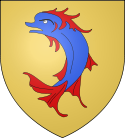
Guigues VIII of Viennois
Encyclopedia

Beatrice of Hungary (1290–1343)
Beatrice of Hungary was the elder daughter of Charles Martel of Anjou and his wife Klementia of Habsburg. She was a member of the Capetian House of Anjou.- Family :...
.
Only nine years of age when his father died, he succeeded under the regency
Regent
A regent, from the Latin regens "one who reigns", is a person selected to act as head of state because the ruler is a minor, not present, or debilitated. Currently there are only two ruling Regencies in the world, sovereign Liechtenstein and the Malaysian constitutive state of Terengganu...
of his uncle Henri Dauphin, the bishop-elect of Metz, which was exercised until 1323. Knight and combatant par excellence, in 1325, at the age of sixteen, he took Varey, near Pont d'Ain, in a brilliant battle against the Savoy
Savoy
Savoy is a region of France. It comprises roughly the territory of the Western Alps situated between Lake Geneva in the north and Monaco and the Mediterranean coast in the south....
ards. Contemporary chronicles say that "l'ost de Savoye fut bellement desconfit." From that date to his death, Guigues was in constant conflict with his Savoyard neighbours.
French influence was reinforced during his reign, especially by his marriage with Isabelle, daughter of Philip V of France
Philip V of France
Philip the Tall was King of France as Philip V and, as Philip II, King of Navarre and Count of Champagne. He reigned from 1316 to his death and was the penultimate monarch of the House of Capet. Considered a wise and politically astute ruler, Philip took the throne under questionable...
. In 1328, at the Battle of Cassel
Battle of Cassel (1328)
The Battle of Cassel was fought on 23 August 1328 by Philip VI, the King of France, and first ruler of House of Valois , against the peasant revolt in Flanders, led by Nicolaas Zannekin. The battle took place near the city of Cassel, 30 km south of Dunkirk in present-day France...
, Philip VI
Philip VI of France
Philip VI , known as the Fortunate and of Valois, was the King of France from 1328 to his death. He was also Count of Anjou, Maine, and Valois from 1325 to 1328...
entrusted the command of the Seventh Corps, with its twelve banners, to him. In the battle, the Flemish burgers were smashed by the French chivalry. For his courage, Guigues was rewarded with the Maison aux Piliers in Grève
Greve
Greve is any of the following:* Greve Municipality, in Region Sjælland on the island of Zealand in Denmark** Greve Strand, the municipal seat of Greve** Greve Station, one of the railway stations in the Danish municipality** Greve Parish...
, Paris
Paris
Paris is the capital and largest city in France, situated on the river Seine, in northern France, at the heart of the Île-de-France region...
.
Guigues was finally killed while besieging the Savoyard castle of Perrière in 1333. He left the Dauphiné
Dauphiné
The Dauphiné or Dauphiné Viennois is a former province in southeastern France, whose area roughly corresponded to that of the present departments of :Isère, :Drôme, and :Hautes-Alpes....
to his brother Humbert II. He was buried in Saint-André in Grenoble
Grenoble
Grenoble is a city in southeastern France, at the foot of the French Alps where the river Drac joins the Isère. Located in the Rhône-Alpes region, Grenoble is the capital of the department of Isère...
.

